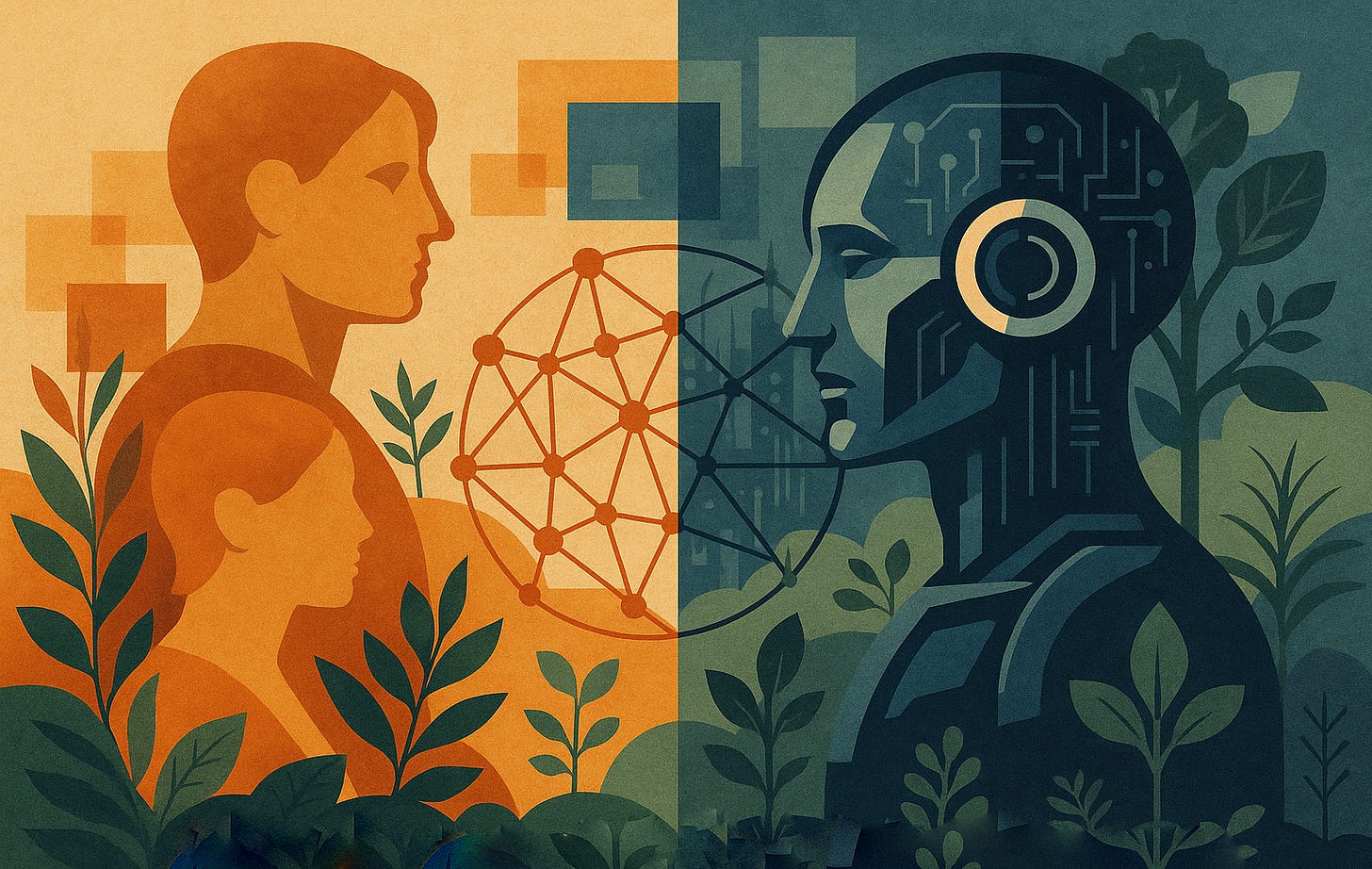Reflections in the Mirror: From Cognitive Simulacra to Regenerative Coherence
Reading Michael Deittrick’s recent piece on Cognitive Simulacra opens up a timely and imaginative vision—one where digital mirrors don’t just reflect the world, but evolve with it. Where intelligence is not something we control or delegate, but something we co-shape in motion. Where the boundaries between sensing, simulating, and acting begin to dissolve in service of more adaptive, intentional futures.
Michael introduces the idea that as AI moves from reactive tools to adaptive co-creators, we enter a future defined not by replacement, but by resonance. He calls this future Co-Humanism: a shared state of intelligence where humans and machines co-evolve through mutual learning, each contributing distinct strengths.
This trajectory raises valuable questions—and opens up space for even broader exploration.
From Tools to Mirrors
Michael’s Cognitive Simulacra aren’t just more powerful tools. They’re living, adaptive systems that sense the real world, simulate future scenarios, and evolve through continuous feedback. They serve not just as representations, but as partners in shaping reality—in science, infrastructure, governance, and everyday life.
He outlines a compelling evolution:
Cognitive Inflection Point – Where we are now: AI responds, humans drive context.
Augmented Agency – AI begins to act within human-defined boundaries.
Cognitive Convergence – Humans and AI begin to form a collaborative intelligence system.
This framing doesn’t just chart a technological arc—it invites a conversation about the kinds of futures we want to co-create.
Hyperreality and the Need for Coherence
One of the most valuable contributions Michael makes is his reinterpretation of hyperreality as a functional field— a fusion of physical experience, digital modeling, and real-time action. In this view, Cognitive Simulacra help us maintain coherence in complex systems by continuously sensing and aligning the digital with the real.
Here’s a practical example:
Hyperreality in Motion: A City Example
Imagine a transportation system where:
Real-time data from roads, weather, and transit systems is continuously collected.
AI simulations forecast future congestion before it happens.
Systems adjust lights, reroute buses, and inform travelers in real time.
Citizens benefit from safer, more reliable movement—while the system continues learning.
Here, digital tools don’t replace the physical city—they help it self-correct and stay aligned with the needs of its people.
That’s the kind of coherence hyperreality can enable—not through control, but through continuous, responsive integration.
The Regenerative Lens: A Directional Extension
As we design and deploy adaptive systems like Cognitive Simulacra, a key question emerges:
What kind of futures are these systems helping to shape—and how do we ensure those futures reflect human and ecological purpose?
Michael outlines how intelligence can be co-created. A complementary question is how these systems can be aligned with regenerative intent—supporting not just functionality, but long-term resilience and well-being for all life and the planet.
In my work on Regenerative Possibility Chains, I focus on how complex systems under pressure face moments of rupture—and how those moments can become hinge points for transformation. Reflexive systems like Cognitive Simulacra could play a vital role here:
Helping us detect when systems are becoming fragile
Simulating alternative futures
And supporting humans in choosing pathways that restore balance, equity, and ecological health
Regeneration brings a directional orientation to the powerful infrastructure Michael describes.
Polyintelligence: Designing for More Than One Way of Knowing
Michael’s vision of Co-Humanism highlights a strong relationship between human and machine intelligence. Another useful complement to this idea is the concept of polyintelligence—the understanding that intelligence comes in many forms, not just human logic or machine computation.
Examples include:
Ecological intelligence – like how forests manage nutrients or how water systems self-regulate
Cultural and community intelligence – traditions, values, and shared practices that help groups adapt over time
Systemic intelligence – feedback patterns and interdependencies that make or break resilience
Designing AI systems that can learn from this broader spectrum of intelligences could help us build solutions that are more inclusive, sustainable, and grounded.
Why it matters:
If AI only reflects our fastest, most technical ways of thinking, we may miss slower, deeper patterns of wisdom. But when it listens across a wider range of inputs—natural, social, ethical—it can become a more balanced and trustworthy partner in shaping the future.
Closing Thought: The Mirror, the Field, and the Compass
Michael ends with a powerful invitation:
“The real question is no longer what we will become—but what we could become together, that we cannot become alone.”
That line captures the essence of what this moment calls for.
Building on that, we might ask:
How do we ensure that what we become together is not only powerful, but also rooted in purpose, guided by wisdom, and aligned with the needs of all life?
Cognitive Simulacra can serve as the mirror—constantly adapting and evolving with us. Polyintelligence reminds us that we live in a field of meaning, not just information.
And regeneration offers a compass—pointing us toward futures that are life-affirming, equitable, and sustainable.
The goal isn’t to steer the future alone—or to hand the wheel to machines. It’s to co-create systems that are capable of listening, adapting, and aligning across many ways of knowing.
That’s the future I want to be part of. And I’m grateful to Michael for opening a powerful door into that conversation.
Further Reading & Related Work
Original article by Michael Dietrich:
Cognitive SimulacraMy work on Regenerative Ecosystems:
Regenerative EcosystemsExplore Regenerative Possibility Chains:
Read the Primer on Substack
Full Article Series on Medium


